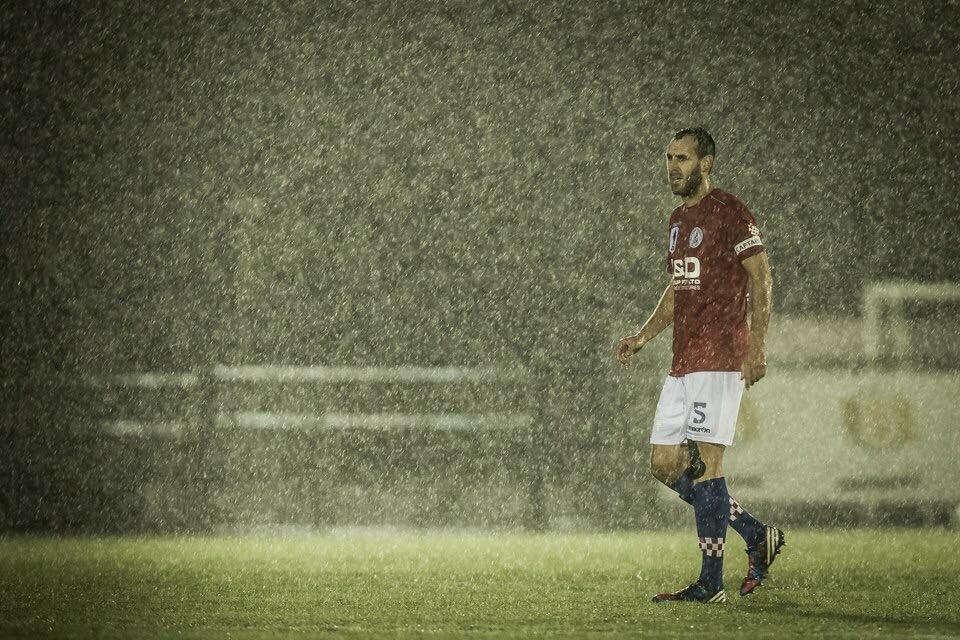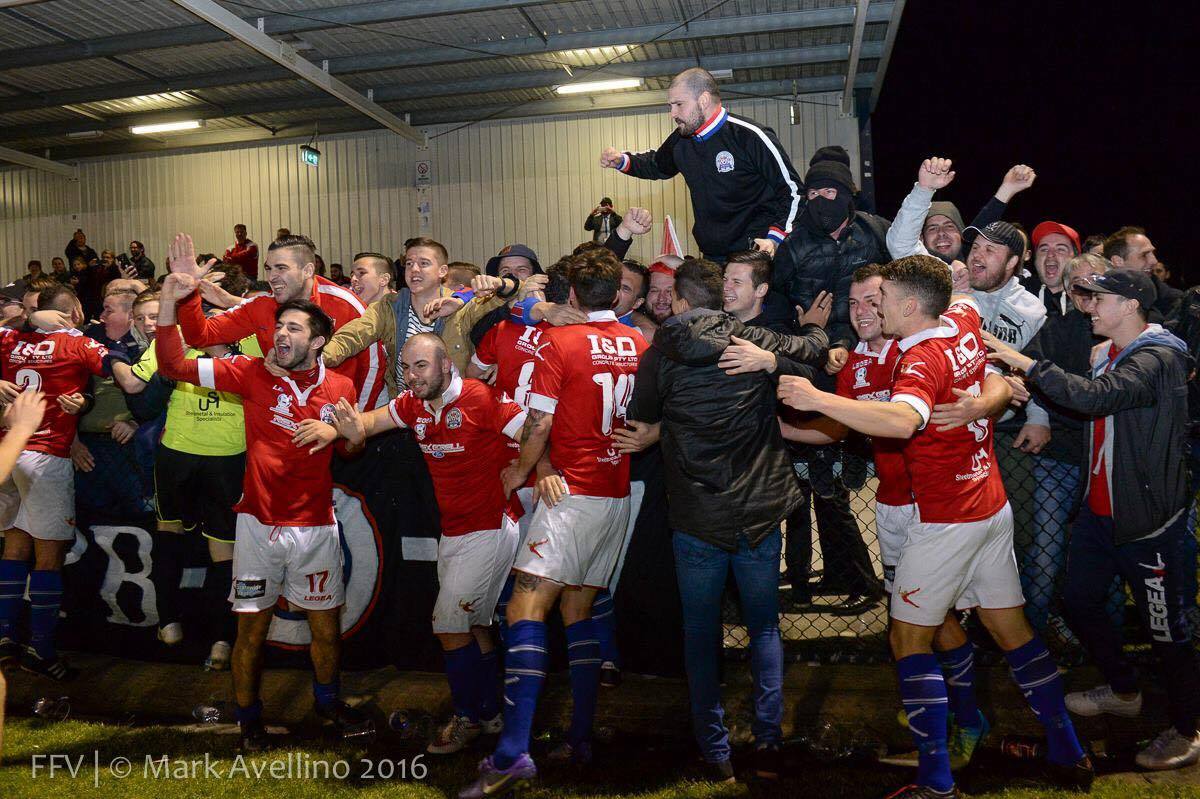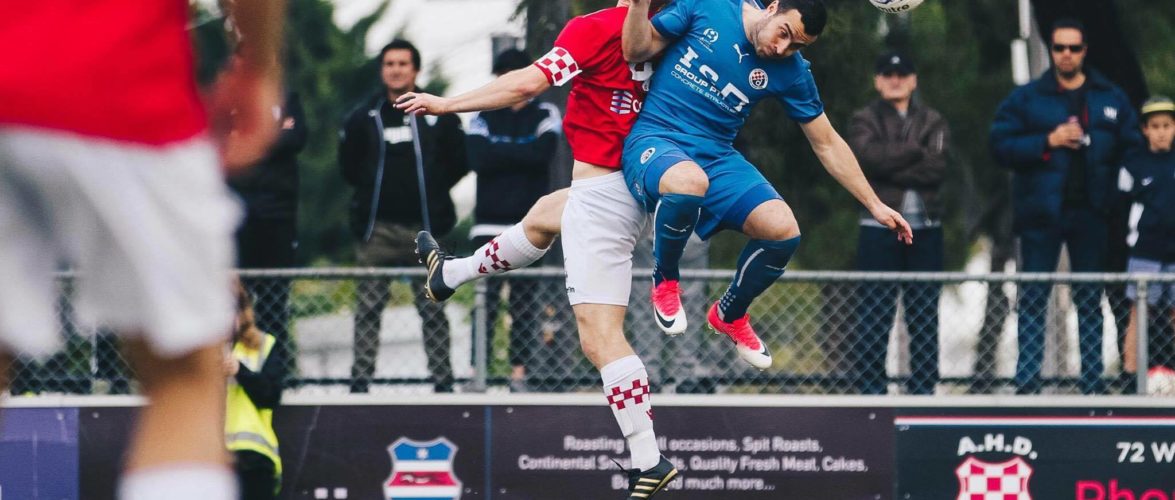Image: Dion Fountas
Dreary conditions matching dreary football at Churchill Reserve might have provided an adequate enough metaphor, as the Melbourne Knights and Saint Albans clashed on Sunday afternoon.
While the Croatian backed clubs respectively sit 12th, 13th and 14th on the NPL1 ladder, one of the cars lined up behind the goals at Fox Street provided a more powerful picture.
A nevertheless jovial atmosphere accompanied the two sides’ agonising struggle to simply score, but one in attendance decided to stay in his car.
Following an excruciatingly dour opening 45 minutes on a pitch more resemblant of a sand dune, by the start of the second half, the man had already dozed off.
With three Croatian backed clubs represented for the first time in Victorian football’s top tier, the numbers themselves are startling: four wins out of a possible 39, an average of 2.03 goals against per game to 0.95 goals for, a total goal difference of -42 and finally, all three face-to-face with relegation to NPL2 at the midway point of the 2017 season.
Walk into the club rooms at Knights Stadium, Churchill Reserve or Elcho Park, and impressive histories are there for all to see.
Various jerseys of players who grew up there before going on to achieve success at club and international level, silverware and championship pennants all make for an striking visual reminder of historical output.
Importantly, those histories are also intertwined with the battle for mere recognition of identity, in contrast to many other European communities that settled in Australia during the 20th century.
With that in consideration, they are histories each club has every right to be proud of, not only in the context of Australian football, but world football.
Now, as the success of all three is linked by heritage, is the current plight on the park similarly connected?
Eager to draw attention to his decimated squad, now former Knights coach Andrew Marth disagrees.
“We should never have been in this predicament. We have got seven players from our starting 11. Patrick (Gerhardt) has been out since day dot, and we have lost a couple of key individuals,” he said.
“Jake (Barker-Daish) has been out as well, Josh (Brekalo) has a broken toe. If they were soft tissue injuries, I’d put my hand up, but these are the kind of injuries you can’t control.
“If I had the same starting 11 week in, week out, we’d be up there and we wouldn’t be out of the FFA Cup, either.”

From a footballing standpoint, however, one only needs to use the last three weeks – with the Knights, Warriors and Saints all facing off against each other – as a reference point to see play has been just as archaic as the mementos in the respective club rooms.
Lines are stretched, while positioning and movement off the ball is rigid, which then means the players with the ball in the front third are regularly left in isolation. It all equates to lateral, ineffective possession.
For the majority, the ball is contained in front of the opposition midfield in central areas and when numbers commit forward, it consequently impairs the ability to stop the counter when the ball is then given away.
A fight to avoid relegation almost always skews objectives in favour of results, to the detriment of aesthetic.
Outside of dead ball situations and the transitional phase, however, all three sides toil to even generate anything more than half-chances.
Focusing on the Knights in context of Marth’s dismissal on Tuesday, despite their horror run of injuries and suspensions to this point, it would be avoidant to say this current state of affairs has come as a shock.
Ultimately, Marth’s dismissal on Tuesday night highlighted the overall absence of foresight, or a mere plan.
Aside from last April’s 6-0 defeat to Oakleigh, the biggest home defeat in the club’s history, heavy losses to Bentleigh and Avondale last season were just as indicative of the side’s lifelessness and inflexibility under him.
Even earlier in the 2016 season, the Knights conceded handfuls against Heidelberg, South Melbourne and a Northcote side that was eventually relegated.
The club limped to the finish line last term, with the one win out of the last seven league matches coming in the form of a Melbourne Victory forfeit.
Their current seven-game winless streak has only given added credence to the notion it long played a one-dimensional brand of football under Marth.
The Knights’ bewildering delay of action in this respect, notwithstanding the fact multiple players headed for the exit when they realised Marth would stay on last summer, only exacerbated matters.
This overall decline in standard calls into question what the club now expects from its players at all levels, and from itself as an entity, especially as a former standard bearer in the Australian game.
Furthermore, it casts doubt over the ability to make critical football decisions and in the wider picture, North Geelong and Saint Albans suffer the same symptoms.
The question is why?
It’s almost impossible to quantify the influence of each, but there are numerous factors at play.
It ranges from a lack of financial means, to a volunteer-based staff and administrative structure, an undermining of competitive purpose within the Australian game, and on a basic footballing level, an inability to adjust to the evolution of the game from a developmental standpoint, for both players and coaches.
While the business model and absence of meritocratic principle is a wider problem at the grass roots level in Australian football, it’s arguably more pronounced for these clubs, where the aforementioned battle for self-determination previously galvanised the Croatian community.
Nowadays, administrative responsibility and a decline in standard is met with indifference.
In contrast to Marth, Saint Albans assistant Josip Loncaric believes the Knights’ success underpins that of the others. The same goes for struggles.
“Knights is always going to be the flagship for these clubs. Whether they’ve done enough to justify that over the last couple of years is another matter,” he said.
“Looking at our junior teams, there’s not much of a difference anymore, whereas growing up as a kid, playing for Knights was a big deal.”
Though players had gone the other way over the years, players who generally couldn’t force their way into the senior team used the likes of Saint Albans, North Geelong and what’s now known as Dandenong City as a channel for first-team football.
For example, Martin Raspudic and Tom Batur never found their way back to Somers Street, despite their roles in the Knights’ National Youth League winning side in 1996/97. They found senior football at Fox Street and Elcho Park respectively.
While crucial formative years were spent at Richmond, Tomislav Uskok helps form a contingent of those who have returned in recent years, though, along with Milan Batur, Marijan Cvitkovic and Nikola Jurkovic.

Today, half of the current North Geelong senior squad played for Melbourne Knights at either junior or senior levels, but Loncaric believes a loss of hierarchy and a general decay in development is affecting all three.
“Is having three clubs in NPL1 stretching our resources? Nobody else is going to help us, but are we big enough as a community to facilitate it in comparison to others? I don’t know, because there are still some really strong youth teams, so it could be just a generational gap,” he said.
“I think for North Geelong and Saint Albans, the goal is just to stay up and slowly build.”
Again, how to combat the stagnation in player and coaching development is a hot topic for the wider footballing community in Australia.
For Loncaric, a school teacher during the week, the onus falls on both individual and club.
“My experience with kids is that, maybe they’re given too much too early, and the drive to succeed as a professional isn’t as big. I see it at club level, however, resilience and good habits probably aren’t being built into their characters as much as they should,” he said.
“I think a lot of coaching in this country, though, has become very structured and kids aren’t really expressing themselves anymore. The applied learning for these coaches after taking courses is probably lacking.
“But, you look at clubs like Real Madrid and Dinamo Zagreb – academies that produce top class players – and you see the fundamental skills that they have at such an early age, our kids aren’t even picking that up at 14, 15.”
North Geelong is a prime example of that growing fear juniors coming through the ranks don’t have sufficient quality to warrant a chance.
Throughout this first half of the NPL1 season, the Warriors have been devoid of polish in front of goal and currently sit 13th, the only side in NPL1 without a win in 2017. Conversely, the Under 20s side is not only 1st, but has scored the most goals in the league.
Now, coach Micky Colina has only 15 players to call upon following Juso Julardzija’s ankle injury, along with the departures of Anthony Banovac and Michael Simms.
On a week-to-week basis, Colina has only one legitimate attacking option off the bench. It’s damning one way or the other, but he has yet to give senior minutes to anyone from Mick Svaljek’s side since Julardzija went down in April.
For Colina, however, the reason for North Geelong’s predicament is simple.
“Every club’s got a different dynamic but the difference in this league is, more and more, coming down to the overall spend on and off the pitch,” he said.
“It’s no secret, the clubs at the top of the ladder in NPL1 are spending more than the others. The only exception to that rule is Pascoe Vale.
“Our spend is the lowest by far in NPL1. Even the top clubs in NPL2 are spending more than us. I’ve often said development and results aren’t friends, and nobody wants to go down, but I think every club has to identify what it is that they want to do.”

Dinamo coach Kruni Razov echoed that sentiment.
“I can only speak on behalf of Dinamo, and where we are, we knew this season was going to be tough,” he said.
“It’s hard to put it nicely, but was every player here ready for this step up? Maybe, maybe not. Some probably needed more time under their belts.
“You can’t play for 35 minutes and win games. That’s the difference against the better sides in NPL1, because they have more depth in their squads. When they make a sub, they make a sub.”
Dandenong City is a counter-point to the other three, in the sense it has greater financial means to assemble a squad in its push for promotion to NPL1.
However, the argument of mere monetary capacity is escapist.
If anything, the inability to compete with Victoria or Australia’s best in financial terms should be a motivator to go against conventional method.
In an environment where the country’s governing football body drags its heels on expansion in the A-League, let alone promotion and relegation, the need to develop footballers to safeguard the futures of these clubs is paramount.
Because for the time being, just like the man in his car behind the goals on Sunday, all three clubs are asleep at the wheel.

